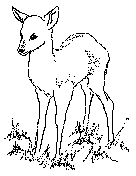 mathtivity of mine for children, "Crittercensus". I drew upon a
passage by Russian-American mathematician, William Feller, in his book,
Introduction to Probability Theory.
mathtivity of mine for children, "Crittercensus". I drew upon a
passage by Russian-American mathematician, William Feller, in his book,
Introduction to Probability Theory.
Wildlife managers often need to estimate the total number of animals in area. They use this information in varous ways. For example, before stocking a lake with largemouth bass, fish biologists need to know if the bass will survive. Largemouth bass feed on smaller fish. By determining how many little fish are in the lake, the biologists can know if there will be enough food for the bass.
Wildlife biologists who study deer often need to know the number of deer in an area. It's relatively easy to know when a deer population is too large if you can spot thin, starving deer, but biolgists want to know the size of the herd before it reaches the starvation point. With information of this kind, they can determind how many deer should be harvested during hunting season to maintain a healthy populatin.
How then does a biologist go about determing wildlife populations? One way is to count the animals, a method used especially with waterfowl. But to count the animals, you need to see them and this is not always possible.
Biostatisticians use several formulas to estimate populations. One of the more simple ones was constructed by a British biologist-statistician, Sir Ronald Fisher. Below is a game for older students using Fisher's Formula to determine the approximate number of "things", in this case beans, without counting.
Put 90 white beans and 10 red beans into a wide-mouth jar, to represent a population of a particular animal or critter, let's say deer. A red bean represent an animal tagged and released. A white bean represents an untagged critter. Note: One hundred is a convenient number to work with, but you can use any number you wish. It's better not to have too small a population.
Tell your students that there are 10 red beans in the jar, but the total number of red and white beans is a secret. They will discover how to estimate this total without counting.
To begin, mix the beans thoroughly. Have a student draw 10 beans at random, one at a time, without looking. Mix the beans thoroughly after each bean is drawn. With 10 beans drawn, use the following Formula to estimate total number of tagged and untagged critters.
- C = (S x T)/R -- where C = total of beans (tagged/ untagged) in jar; S = sample size (here, 10); T = total number of tagged critters in population (told as 10); R = number of tagged critters in the sample.
- C = ?; S = 10; T = 10; R = 1. So C = (10 x 10)/1 = 100 estimated critters in the population.
- Then, C = ?; S = 10; T = 10; R = 2. So, C = 100/2 = 50.
Suppose, for example, you draw 10 samples of 10 (S) critters each (replacing each sample of 10 and mixing before the next sample is drawn) with thwe following results:
| SAMPLE NUMBER | SAMPLE SIZE (S) | MUMBER TAGGED CRITTERS (R) |
| 1 | 10 | 1 |
| 2 | 10 | 1 |
| 3 | 10 | 3 |
| 4 | 10 | 1 |
| 5 | 10 | 0 |
| 6 | 10 | 2 |
| 7 | 10 | 1 |
| 8 | 10 | 1 |
| 9 | 10 | 0 |
| 10 | 10 | 1 |
- C = (100 x 10)/11 = 90.9.
With repeated sampling, you have The Law of Large Numbers working for you. It says that by repeatededly compounding samples, the estimates get better and better.
Have students draw a larger number of samples -- perhaps 100 samples of 10 each. The more they sample, the better their estimate will be.
Tell your students the watchword of the Statistician: "May
the Great Bird lay a good estimate in your nest!"